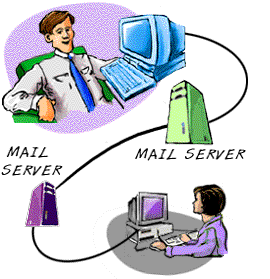 It
can take days to send a letter across the country and weeks to go around the
world. To save time and money, more and more people are using electronic mail.
It's fast, easy and much cheaper than the using the post office.
It
can take days to send a letter across the country and weeks to go around the
world. To save time and money, more and more people are using electronic mail.
It's fast, easy and much cheaper than the using the post office. e-Mail - How It Works
 It
can take days to send a letter across the country and weeks to go around the
world. To save time and money, more and more people are using electronic mail.
It's fast, easy and much cheaper than the using the post office.
It
can take days to send a letter across the country and weeks to go around the
world. To save time and money, more and more people are using electronic mail.
It's fast, easy and much cheaper than the using the post office.
What is e-mail? In its simplest form, e-mail is an electronic message sent from one computer to another. You can send or receive personal and business-related messages with attachments, such as pictures or formatted documents. You can even send music and computer programs.
Let's say you have a small business with sales reps working around the country. How do you keep in contact without running up a huge phone bill? Or what about keeping in touch with far-flung family members? E-mail is the way to go. It's no wonder e-mail has become the most popular service on the Internet.

Just as a letter makes stops at different postal stations along its way, e-mail passes from one computer, known as a mail server, to another as it travels over the Internet. Once it arrives at the destination mail server, it's stored in an electronic mailbox until the recipient retrieves it. This whole process can take seconds, allowing you to quickly communicate with people around the world at any time of the day or night.
To receive e-mail, you must have an account on a mail server. This is similar to having an address where you receive letters. One advantage over regular mail is that you can retrieve your e-mail from anywhere location. Once you connect to your mail server, you download your messages to your computer.
To send e-mail, you need a connection to the Internet and access to a mail server that forwards your mail. The standard protocol used for sending Internet e-mail is called SMTP, short for Simple Mail Transfer Protocol. It works in conjunction with POP servers. POP stands for Post Office Protocol.
When you send an e-mail message, your computer routes it to an SMTP server. The server looks at the e-mail address (similar to the address on an envelope), then forwards it to the recipient's mail server, where it is stored until the addressee retrieves it. You can send e-mail anywhere in the world to anyone who has an e-mail address. Remember, almost all Internet service providers and all major online services offer at least one e-mail address with every account.
|
|
TRY
THIS... Send yourself a message. Click on this link. When the e-mail window appears, type your address in the TO: field, then fill in the Subject field and write a note. Now click the Send button. In a few minutes, your message should appear in your Inbox. |
At one time, Internet e-mail was good only for text messages. You couldn't send attachments, such as formatted documents. With the advent of MIME, which stands for Multipurpose Internet Mail Extension, and other types of encoding schemes, such as UUencode, not only can you send messages electronically, but you can also send formatted documents, photos, sound and video files. Just make sure that the person to whom you send the attachment has the software capable of receiving/decoding it.